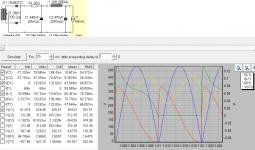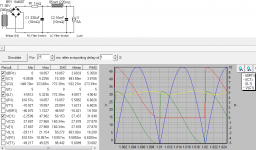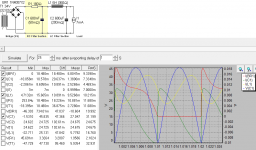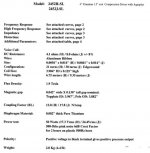All I could find to dig up were these three power supplies I designed for a pair of amps. A high Voltage supply, a high current supply and a high impedance low Voltage and current supply. Each was built and used.
The takeaway is the philosophy has been translated orders of magnitude apart.
The takeaway is the philosophy has been translated orders of magnitude apart.
Attachments
It´s in the equation you are quoting.how is the "length of coil" a factor in discussing BL??
Here L does not mean inductance but Length.
Wire length.
That is true in transformers or solenoids where you use thinner wire, you not only add more turns, but more layers.davidsrsb
Its really hard to generalize this, the 8 Ohm will have more turns of thinner wire, which partly makes up for the halved motor current.
The mass of the two coils is going to be similar, the gap is filled with copper either way.
On speaker voice coils you have 2 layers, period.
So using thinner wire gives you a lighter coil, only partially compensated by the added turns.
Read above, a 2 layer 4 ohm voice coil will be heavier than 2 layer in 8 ohm.Kay Pirinha
I fully second davidsrsb's arguments. There's no reason why a 8 ohm VC should be heavier or lighter than a 4 ohms one, and why the »motor strenghts« should differ.
Do th math.
Number of turns (and total wire length) is inversely proportional to wire diameter while mass-per-length unit is directly proportional to square of diameter.
So they run opposite ways but don´t cancel each other.
JBL, EV, Beyma, RCF are the exception to the rule (no real"exception" because they use a different Technology) becaue they use edgewound ribbon wire, a rectangular section one, and aspect ratio is customized for each peaker; 99.9999% of speakers in the World use 2 layers of round wire, which follows the Geometrical rules I wrote above.Kay Pirinha
These arguments are backed for instance by the TSP's of JBL transducers that are available in different impedance values. The only parameters that differ are RE, LE and BL. All others, especially efficiency, are identical.
But it does not.Tweet
If the 8 ohm version has twice the number of turns on the voice coil as does the 4 ohm version, the back EMF of the 8 ohm driver will be twice that of the 4 ohm driver.
Too sleepy now , will do the Math tomorow,but think in the order of 40% lon ger, not double by any means.
Double turns means half the diameter with 1/4th the resistivity so **8 times** higher impedance so about 32 ohm, not 8.
turk 182
in this definition from Eminence
BL
Expressed in Tesla meters, this is a measurement of the motor strength of a speaker. Think of this as how good a weightlifter the transducer is. A measured mass is applied to the cone forcing it back while the current required for the motor to force the mass back is measured. The formula is mass in grams divided by the current in amperes. A high BL figure indicates a very strong transducer that moves the cone with authority!
L means Length here.there's no mention of coil length.....?
Meter is a unit of Length.
True.Pharos
"Expressed in Tesla meters," - Implicit in this is length, and yes, within the gap.
it is not factored *there* because that is the definition of "B" alone.turk 182
from wikipedia
One tesla is equal to one weber per square metre.
which is a unit of field strength over an area, so please show where "coil length" is factored.
While when calculating "engine strength" you use B*L
True.Charles Darwin
Comparing the 4Ω and 8Ω versions of the Faital 12HP1060 show some differences.
Most obvious is the Mms of the 4Ω is 138.7g while the 8Ω is 126.9g
The 4 ohm motor will be "stronger" than the 8 ohm one, ONLY if you keep voltage constant, which in due time wikkl drive current I.YSDR
And the motor force factor is obviously more on the 4 Ohm version. More moving force results in a lower Qes, hence lower Qts. Motor force factor = (BL x BL)/Re.
But that is cheating, because you are now applying twice the power!!!!
The fair and proper comparison means applying same power to both, so lower voltage to the 4 ohm one. (0.707x)
You do not have such a liberty.turk 182
is that where topology takes hold, i can wind a lengthy coil on a small diameter or wind the same length of wire on a large diameter and wind up with a shorter coil?
so which results in a greater Bl?
Magntic Gap real estate is STRICTLY limited,in practical terms it´s FIXED for a given magnet.
In practice a smaller diameter voice coil will accomodate a smaller wire length and a larger diameter coil a larger length of wire.
Remember (useful) bobbin length *IS* top plate thickness, plus a little fringe field.
A longer winding coil will have turns outside the gap, pushing nothing (because of no B present) and slowing everything (added mass).
Imagine adding a second engine to a car ... and not feeding gasoline to it.
Read above.Even though the 4 Ohm version have higher moving mass, the greater motor force overcompensate this.
Sorry, REALLY sleepy, will continue tomorrow checking this thread.
Last edited:
Yes obviously, otherwise what is the purpose of the lower impedance version of a driver if we can't send more current with the same voltage?While when calculating "engine strength" you use B*L
True.The 4 ohm motor will be "stronger" than the 8 ohm one, ONLY if you keep voltage constant, which in due time wikkl drive current I.
But that is cheating, because you are now applying twice the power!!!!
The fair and proper comparison means applying same power to both, so lower voltage to the 4 ohm one. (0.707x)
And with that, we've come to see that when we pump more power into a driver, we increase the driving forces, so the T/S parameters also change so that the Qes in particular get lower. T/S parameters are valid only if we know the applied power.
Last edited:
Minimum Qes-Qts is achievable with series voice coils, not parallel.
Well I can understand if as said earlier Qes doubles if one coil is used in a twin coil driver, or to turn it round Qes is halved if both coils are used. If the quote at the top of this is right, how much difference is there to Qes if the coils are series or parallel? Is one configuration more or less than half.
If the quote at the top of this is right, how much difference is there to Qes if the coils are series or parallel?
Check Visaton GF200 2x4 Ohm, there are parameters for every configuration with the 2 coil:
GF 200 - 2 x 4 Ohm | Visaton
No. For doubling the resistance of a wire, you wind sqrt2 times the length of a 1/sqrt2 times the cross section area wire. Hence the same volume and mass!Read above, a 2 layer 4 ohm voice coil will be heavier than 2 layer in 8 ohm.
Do th math.
Number of turns (and total wire length) is inversely proportional to wire diameter while mass-per-length unit is directly proportional to square of diameter.
So they run opposite ways but don´t cancel each other.
Best regards!
BTW - I'm watching this thread with great interest. A lot of it flies straight above my head. However, I had asked a similar, but inverse question a month or so ago re: why some amps may sound better with my particular "4 ohm" speakers. I am just now starting to understand why there are various impedance curves for speakers and how speakers and amplifiers can work well together (or not).
To those that contribute and share their knowledge - THANK YOU!
To those that contribute and share their knowledge - THANK YOU!
No.Minimum Qes-Qts is achievable with series voice coils, not parallel.
I just measured Alpine dual voice coil (2+2 ohm, four layers) woofer SWR-8D2:
- parallel voice coils: Qts = 0.65 (input signal = 2 V)
- serial voice coils: Qts = 0.67 (input signal = 4 V)
Woofer is brand new, unused before - not "burned-in". Measured TS parameters were essentially the same with 2 or 4 V signal (CLIO).
There was slight difference in Re between the two voice coils, presumably because of different length of inner and outer coils.
So, we can safely conclude that parallel (vs. serial) voice coils brings lower (or equal) Qts.
For 4 and 8-ohm versions of the same model (not to be confused with the dual voice coil woofers!), Qts is lower in the 4-ohm version, notwithstanding some exceptions from the professional world of loudspeakers.
This shows very clearly how JBL uses the thickness the wire used in edge wound coils to determine 8 VS 16 ohm in their assemblies. Example 2452 compression driver.
And the T/S do change but only in the relevant parameters.
Rob 🙂
And the T/S do change but only in the relevant parameters.
Rob 🙂
Attachments
Last edited:
BTW - I'm watching this thread with great interest. A lot of it flies straight above my head. However, I had asked a similar, but inverse question a month or so ago re: why some amps may sound better with my particular "4 ohm" speakers. I am just now starting to understand why there are various impedance curves for speakers and how speakers and amplifiers can work well together (or not).
To those that contribute and share their knowledge - THANK YOU!
I also think this is a great thread; with the interaction we can all gain more, and this devoid of the privileged formative years, and benefits a good formal education confer.
Surely this is what the spirit of real humanity can offer, and in a direction which is morally innocuous.
The 4 ohm motor will be "stronger" than the 8 ohm one, ONLY if you keep voltage constant, which in due time will drive current I.
But that is cheating, because you are now applying twice the power!!!!
The fair and proper comparison means applying same power to both, so lower voltage to the 4 ohm one. (0.707x)
*Explosion*
Wishful thinking methinks. I used to equate my anecdotal knowledge of the experience of previous generations, to my real experience. Then I came here and discovered it was just superficial.devoid of the privileged formative years, and benefits a good formal education confer.
No. For doubling the resistance of a wire, you wind sqrt2 times the length of a 1/sqrt2 times the cross section area wire. Hence the same volume and mass!
Best regards!
And you end with a useless voice coil because now *winding length* (not wire length ) changes!
Winding length is number of turns multiplied by wire diameter
Suppose you have a 10 mm gap length and a maximum efficiency voice coil, occupying 10mm length (winding length) along the former.
Using the design you suggest:
* 1.4142x turns
* 0.707x cross section
BUT new diameter will NOT be 0.707x the former one (what you are assuming in the above equation) , it will rather be SQRT 0.707 * former diameter, some 0.84X
So new winding length will be, using my generic voice coil example:
* 1.4142 * 0.84=11.9mm
Which of course is unacceptable.
You are modifying winding length, an IMPORTANT parameter, now 20% of the coil is OUTSIDE THE GAP.
I have been correcting some inaccurate assumptions along this thread, which of course I consider written in good faith and by Technically savvy Forum members, because common design practice does not apply under the STRICT space, weight and geometry constraints present in very specialized Loudspeaker design.
Me? I design and manufacture speakers for a living, for over 40 years now (probably around 45) and suffer the absolutely opposing requirements and compromises which have to be made here.
Mind you, Physics DO apply (of course), but design must bend backwards to comply with what loudspeakers need.
I don't know if I can follow all of this thread...can we say that higher ohms has the upper hand in the terms of Thd and thermal efficiency or are we saying that its really just a case by case scenario, and has to be treated individually?
What happens here, I'm pretty certain higher ohms wins.The 4 ohm motor will be "stronger" than the 8 ohm one, ONLY if you keep voltage constant, which in due time will drive current I.
But that is cheating, because you are now applying twice the power!!!!
The fair and proper comparison means applying same power to both, so lower voltage to the 4 ohm one. (0.707x)
Last edited:
I know the feeling. I've always wished there were more 800 ohm speakers available.Yes obviously, otherwise what is the purpose of the lower impedance version of a driver if we can't send more current with the same voltage?
I think it is a non issue, and even if it is, the small differences may well be obscured in the design by other more major necessary differences.
Can we say that higher ohms has the upper hand in the terms of Thd and thermal efficiency... I'm pretty certain higher ohms wins.
No, no and no.
THD will depend primarily on the amplifier and, if appropriately designed amplifiers are used, it will be an irrelevance. There is one exception to consider in that current-dependent DRIVER non-linearities could be worse in the lower impedance case, which could contribute up to 3dB extra third harmonic distortion. But (again) an appropriately designed driver should ameliorate this in its design and construction (although many do not).
The thermal efficiency is the same for both drivers if both the power input and the volume of coil are the same - which as expressed earlier are requirements for a valid comparison.
So no, higher impedance is not better unless the design is meant to use a higher impedance. Lower impedance often permits an easier route to higher SPLs because many amplifiers are designed to be able to drive lower impedances that can arise due to ill-designed crossovers. And where there is no penalty from doing so, the lower impedance solution might well "win".
- Home
- Loudspeakers
- Multi-Way
- Low impedance = better sound?



